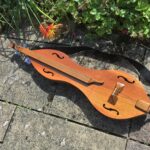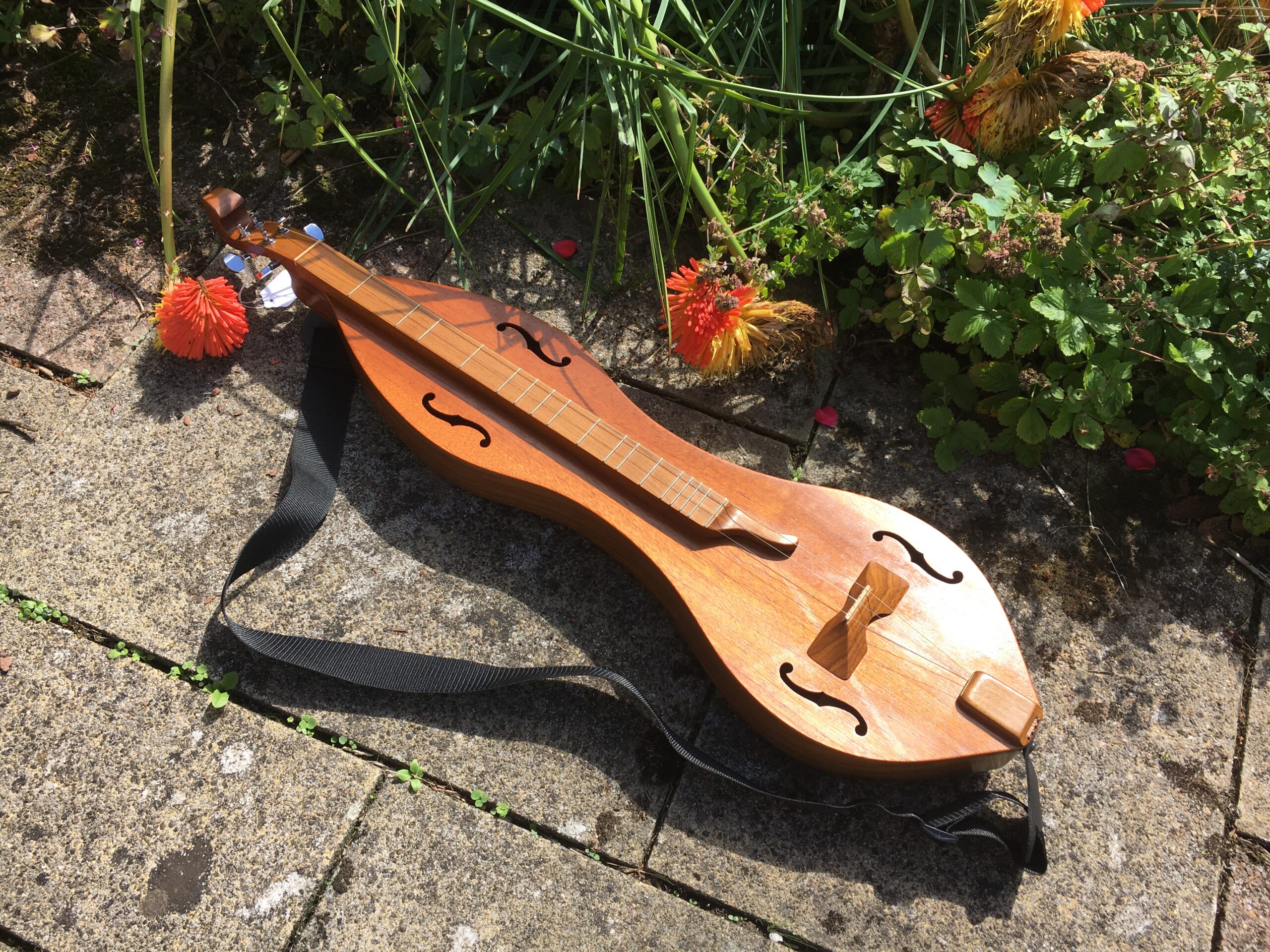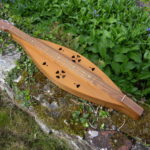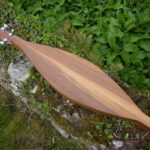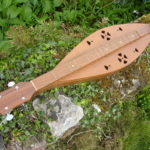Kurt Simerman Dulcimers
Kurt first became attracted to the mountain dulcimer in the 70s when staying with relatives in the Appalachian Mountains. He started to earn his living from making furniture and dulcimers, the latter from 1984. He moved from Kentucky to Leo, near Fort Wayne, Indiana, in 1995 or 1996 and continued developing his dulcimers. At some point he also became a minister of the Evangelical Lutheran Church of America. Kurt died, sadly young at the age of 45, in 2007.
His instruments are now much sought after and very expensive, partly because of their superb craftsmanship but mainly because, through Kurt’s innovative design, they are very clear, loud and crisp.
2.232 1996 Simerman Hourglass #320 4 String, 3 or 4 Course £Sold
Small oblong printed label: “Simerman Dulcimers/ No. 320/ Kurt Simerman [signature]/ Leo, Indiana, 1996”.
Distinctive shape with fairly shallow but wide body, especially so in the lower bout. Body made from bookmatched walnut with reddish/brown mahogany (?) top. Guitar-type fan bracing in lower bout under the (isolated) bridge. Soundholes are S-shaped with diamond centres. Narrow, flat headstock with vestigial “scroll”, on which are mounted guitar-type, chrome Ping tuners. Composite nut and saddle, latter mounted in arched walnut bridge and adjustable for height by means of Allen grub screws underneath. Fingerboard is walnut (with no overlay) with a curled extension for support when playing fingerstyle (now floating, as opposed to earlier one fixed on body top). Neat little lozenge-shaped walnut string anchor assembly, mounted on top of tail, through which the strings pass – from the usual mushroom-headed brass pins, through the body of the tail assembly, past a brass strainer (made from a fret) to get the right angle of attack for the bridge. Overall length 38½”, upper bout 7⅛”, lower bout 9½”, body height 2⅛”, FBW 1½”, VSL 25⅛” (short scale), weight 2lb 4oz (1005g). 6+ and 13+ fret. Strings originally 10/10, 14, 24w; now 11, 15, 25w.
As with my own, earlier Simerman, forceful yet musical. Intonation good on treble, less so on bass side at top of scale (only 2 octave range). Balance of treble and bass is excellent and will cut through when pressed. Design has continued to evolve and construction is uniformly excellent.
Click on images below to enlarge.
2.187 1993 Crystal Creek/Simerman Tearwell 4 String 3 Course £Sold
Part-printed label: “Kurt Simerman [h/w]/ No. 38 [h/w] 1993/ Goshen Kentucky”.
This is a very early dulcimer from Kurt, with an unusual design and the kind of rough edges you might expect from a luthier who was still exploring his craft. Walnut body, with some hints of lighter sapwood, neatly bookmatched on the back and braced internally along the middle, but little elsewhere. No kerfing on the sides. Western red cedar top with quite a wide flared grain towards the middle. Elliptical shape, called a “tearwell” in the contemporary Crystal Creek catalogue which came with it. Odd flat walnut head shape, reminiscent of the later headstocks but with slightly less elegant proportions, on which are mounted enclosed nickel tuners. White hardwood (maple?) nut and bridge on walnut fingerboard. Similar whiteish/light brown hardwood markers at frets 3, 7, 10 and 14. 6+ and 13+ frets are present. Complex flower-shaped (?) soundholes, again not wholly successful. The long expanse of fingerboard behind the bridge shows how long the actual body is. String anchors are mushroom-headed pins in the slightly rounded profile, narrow tail. “I was digging around in my safe and found another piece of info on the dulcimer. It is made of walnut and red cedar” – First Owner, Russ Payne.
Overall length 36¾”, middle bout 7⅝”, body height 2”, FBW 1⅝”, VSL 27⅜” (medium scale), weight 2lb 01oz (939g). 6+ and 13+ fret. Strings now 11/[11], 15, 25w.
Good sound, though not particularly characterful, but with good dynamics and volume if required. Intonation is OK but a little out at the second octave. For such an early creation, the workmanship is excellent, though the design is clearly still being developed – e.g. the head shape and the slightly too thick cedar top.
Click on images below to enlarge.

